词汇学复习范围
- 格式:docx
- 大小:14.08 KB
- 文档页数:2
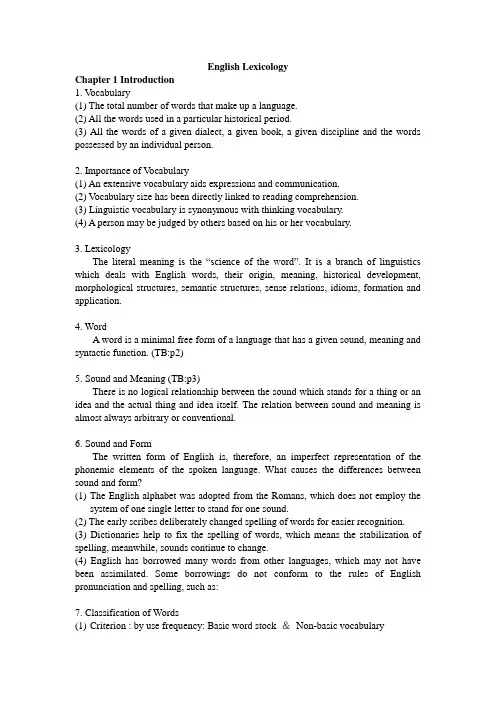
English LexicologyChapter 1 Introduction1. V ocabulary(1) The total number of words that make up a language.(2) All the words used in a particular historical period.(3) All the words of a given dialect, a given book, a given discipline and the words possessed by an individual person.2. Importance of V ocabulary(1) An extensive vocabulary aids expressions and communication.(2) V ocabulary size has been directly linked to reading comprehension.(3) Linguistic vocabulary is synonymous with thinking vocabulary.(4) A person may be judged by others based on his or her vocabulary.3. LexicologyThe literal meaning is the “science of the word”. It is a branch of linguistics which deals with English words, their origin, meaning, historical development, morphological structures, semantic structures, sense relations, idioms, formation and application.4. WordA word is a minimal free form of a language that has a given sound, meaning and syntactic function. (TB:p2)5. Sound and Meaning (TB:p3)There is no logical relationship between the sound which stands for a thing or an idea and the actual thing and idea itself. The relation between sound and meaning is almost always arbitrary or conventional.6. Sound and FormThe written form of English is, therefore, an imperfect representation of the phonemic elements of the spoken language. What causes the differences between sound and form?(1)The English alphabet was adopted from the Romans, which does not employ thesystem of one single letter to stand for one sound.(2) The early scribes deliberately changed spelling of words for easier recognition.(3) Dictionaries help to fix the spelling of words, which means the stabilization of spelling, meanwhile, sounds continue to change.(4) English has borrowed many words from other languages, which may not have been assimilated. Some borrowings do not conform to the rules of English pronunciation and spelling, such as:7. Classification of Words(1)Criterion : by use frequency: Basic word stock &Non-basic vocabulary(2) Criterion: by notion: Content words &Functional words(3) Criterion : by origin: Native words &Borrowed words(4) Criterion: by morphology: Simple words, Compounds &Derived words, etc. 8. Features of Basic Word Stock(1)All national character (2) Stability (3) Productivity (4) Polysemy(5)Collocability9. Content and Functional WordsContent words constitute the main body of the English vocabulary and the number is ever growing, such as nouns, verbs, adjectives, adverbs and numerals. Functional words are stable and take a very small part of the vocabulary, i.e. prepositions, conjunctions, auxiliaries and articles10. Native and Borrowed WordsNative words are not native, but words brought to Britain in the fifth century by the German tribes: the Angles, the Saxons, and the Jutes. Words taken over from foreign languages are known as borrowed words.Chapter 2 Development of English Vocabulary1. Indo-European Language FamilyThere are main three branches in Indo-European language family: Germantic branch, Latin branch and Slavic branch.2. Historical Influence(1) Britons: The early inhabitants of the island we now call Britain were Britons, a tribe of Celts. Their language were dialects of a small branch of the Indo-European language family— Celtic.(2) The Roman conquest: In BC 55-54 Britain was invaded by the Roman conqueror, Julius Caesar. During the 400 years of Roman occupation, the official language of government was Latin.(3) The English conquest: At the beginning of the fifth century Britain was invaded by three tribes from the Northern Europe: the Angles, Saxons and Jutes.Historical Influence(4) The Danish invasion: King Alfred the Great (849-901) succeeded in driving the Danes off with force. Laying down his sword, Alfred set himself to the task of encouraging education and literature.(5) The Norman Conquest: The French-speaking Normans Duke William came in 1066. When Norman and English intermingled, many terms emloyed by Normans were adopted into English language.3. Historical Phases(1) Old English (450-1160): Old English was a highly inflected language. Nouns, pronouns, adjectives, verbs and adverbs had complex systems of endings or vowelschanges or both, which differ greatly from the language that we use today.Historical Phases(2)Middle English (1150-1500): The Middle English period was one of great changes,changes more extensive and fundamental than those that had taken place at any time before and since.(3)Modern English (1500 up to now): This period may be divided into two parts: the Early Modern English (1500-1700) and the Late Modern English (1700- now).Early Modern English: The chief influence of this time was the great humanistic movement of the Renaissance. In this period the study of the Latin and Greek on English was great.Late Modern English: With the rapid development of modern science and technology; social economic and political changes; the influence of other cultures and languages, new words today sweep in at a rate much faster than at any other historical period of time.4. Foreign Elements in English V ocabularyEnglish vocabulary owns most of its words from foreign language, in which Latin, Greek, French and Scandinavian stand out as the major contributors. Other languages have also done their part, such as Italian, German, Dutch, Spanish, Portuguese and Celtic, etc.5. Characteristics of English Language(1) Receptivity, Adaptability and Heterogeneity(2) Simplicity of inflection(3)Relatively Fixed Word-order6. Modes of V ocabulary Development: Modern English vocabulary develops through three channels: creation, semantic change and borrowing.Chapter 3 Morphological Structure of English Words1. MorphemeIt is the smallest meaningful unit of language, consisting of a word or part of a word that can‟t be divided without losing its meaning.2. MorphologyIt is the study of the morphemes of a language and of the way in which they are joined together to make words.3. Types of Morphemes(1) Free and Bound MorphemesMorphemes that can exist as individual words are free morphemes. Others which function only as a word part are bound morphemes.(2) Derivational and Inflectional MorphemesMorphemes which are used to derive new words are known as derivational morphemes because when these morphemes are conjoined, new words are derived.(TB:P47)Inflectional morphemes, in contrast, indicate the syntactic relationships between words and function as grammatical markers.4. Morpheme and Word-formationIn morphology, words can be analyzed into morphemes, however, morphemes are conventionally labeled root, stem, base and affix in word-formation.5. Root, Stem and Base: What are the differences within them?Root is a basic form of a wor d which can‟t be f urther analyzed without total loss of identity. Root cannot be further divided and carries the fundamental meaning.Stem refers to the part after moving inflectional markers.Base is the part that can take affix of any kinds (derivational and inflectional). Chapter 4 Word Formation1. The expansion of vocabulary in modern English depends chiefly on word formation. The most productive are affixation(30%-40%), compounding(28%-30%) and conversion(26%). The rest of the new words come from shortening(8%-10%), blending(1%-5%) and other means.(P54)2. Affixation (or derivation) is generally defined as the formation of words by adding derivational affixes to roots to supply grammatical or lexical information. The morphological structure of an English word: (prefix) + root + (suffix)3. Prefixation: The process of adding a prefix to the root is called prefixation. English prefixes usually do not change the word class. Types of Prefix (TB:P55)4. Suffixation is the formation of a new word by adding a suffix to the tail end of a stem, which usually changes the lexical category of the stem. Types of Suffix. Similar to the exception to the prefixes, some suffixes do change or modify the meaning without changing the lexical categories.5. Compounds: The process of combining two or more than two existing words together to form new lexical items is called compounding.6. Characteristics of Compounds(1) According to orthographic criterion, compounds are written in three ways:1) solid 2) hyphenated 3) open(2) Phonologically, compounds can often be identified as having a main stress on the first element and a secondary stress on the second element.(3) Semantically, compoun ds can often be identified as “having a meaning which may be related to but can not simply be inferred from the meaning of its parts.7. Conversion is a main type of word-formation shifting the base to a different word class with no change of form. Converted words are often short, vivid and expressive,8. Blending is a process of word-formation in which a new word is formed by combining the meanings and sounds of two words, one of which is not in its full form or both of which are not in their full forms.9. Clipping refers to a word-formation process which involves the deletion of one or more syllables from a word (usually a noun), which is also available in its full form.10. Initialism is a type of shortening, using the first letter of words to form a proper name, a technical term, or a phrase, and initialisms are pronounced letter by letter.11. Acronymy: The process of forming new words by joining the initial letters of names of social and political organizations or special noun phrases and technical terms.12. Words From Proper NameIt refers to the coinage of common words from proper names. They come from all sources, from names of scientists, politicians and statesmen, trademarks, names of places, literature, TV films, movies, book titles etc.13. Analogy: A new word or a new phrase is coined by an analogy between a newly created one and an existing corresponding one.Chapter 5 Word Meaning and Componential Analysis1. Word MeaningGenerally speaking, a word is the combination of word-formation and its meaning. …Form‟ refers to both its pronunciation and spelling. …Meaning‟ is what the form stands for. Word meaning can be defined as a reciprocal relation between form and referent.2. Semantic TriangleConcept is the general idea or meaning which is associated with a word or symbol in a person‟s mind.Reference is the relationship between language and the world. The reference of a word to a thing outside the language is arbitrary and conventional.3. Motivation of MeaningMotivation refers to the connection between the linguistic symbol and its meaning, which is divided into 4 types. They are phonetic motivation, morphological motivation, semantic motivation and etymological motivation.(1) Phonetic Motivation (or Onomatopoeic motivation) explains the words whose sounds suggest their meaning, because these words were created by imitating the natural sounds or noise.(2) Morphological motivation (or grammatical motivation) concerns the words whose morphological structures suggest the meaning, such as, the meaning of a derived wordor a compound is based on the meaning of the word-building.(3) Semantic motivation is the mental associations based on the conceptual meaning of a word, i.e. the figurative sense of a word suggested by the literal sense.(4) Etymological motivation explains the words whose meanings are closely associated with their origins, i.e. the meanings of the words suggested by their sources.(5) Motivation by Analogy: Words are created in imitation of other words4. Types of Meaning(1) Grammatical & Lexical MeaningGrammatical meaning indicates all the inflectional forms of words, such as singular and plural meaning of nouns, tense meaning of verbs and so on. Lexical meaning is the meaning of an isolated word in a dictionary. This component of meaning is identical in all the forms of the word.(2) Conceptual & Associative MeaningConceptual meaning is meaning given in the dictionary and forms the core of word meaning. Associative meaning is a supplement to the conceptual meaning, which is open-ended and indeterminate, liable to the influence of such factors as culture, experience, religion, etc.(3) Connotative Meaning refers to the overtones or associations suggested by the conceptual meaning.(4)Stylistic Meaning: Apart from conceptual meanings, many words have stylistic features, which make them appropriate for different styles.(5) Affective Meaning expresses the speaker‟s attitude towards the person or thing in question. This meaning can be conveyed simply by the choice of the right words.Words that have emotive values may fall into two categories: appreciative and pejorative. Words of positive overtones are used to show appreciation or the attitude of approval; those of negative connotations imply disapproval, contempt or criticism.5. Word Meaning and ContextWord meaning depends upon context. The context determines which meaning out of all the possible meanings is to be attached to the word. Generally speaking, when used literally, words have their original meaning; when used figuratively, words have symbolic meaning.6. Components of word meaningAll lexical items can be analyzed into a set of semantic features or semantic components which may be universal. This semantic theory is called Componential Analysis (CA), such as:horse, cat, machine, chair [+/-animate]water, gas, stone, tree [+/-count]sit, cry, read, give [+/-transitive]road, house, thought, philosophy [+/-concrete]Chapter 6 Sense Relations1. Sense RelationsWords are arbitrary symbols and are independent identities so far as spelling and pronunciation are concerned. Sense relations means all words are related in one way or another. In light of sense relations, words can be classified semantically.2. Types of Sense Relations(1)Polysemy(2) Hyponymy---semantic inclusion(3) Synonymy---semantic similarity(4) Antonymy---semantic opposition(5) Homonymy3. PolysemyWhen a word is first coined, it is always the case that it has only one meaning (monosemic). But in the course of development, the same symbol may be used to express new meanings. The result is polysemy, which shows the economy and efficiency of human languages.4. Meanings of Polysemy(1) A word has two or more meanings in which one is the basic, original meaning (Primary meaning), and the others are derived from the basic meaning (Secondary meaning).(2) It is possible that a word is endowed with different word classes, such as noun, adj., verb.5. Diachronic and SynchronicDiachronic approach is assumed to be the result of growth and development of the semantic structure of one word. Synchronically, polysemy is viewed as the coexistence of various meanings of the same word in one historical period of time.6. Concatenation is a process in which the meaning of a word moves gradually from its primary meaning by successive shifts, like the links of a chain, until there is no connection between the meaning that is finally developed and the primary meaning.7. Radiation is a process in which the primary meaning stands in the center, and the derived meanings radiate from it in every direction like rays. All the derived meanings can be traced back to the primary meaning.8. Hyponymy deals with the relationship of semantic inclusion. It refers to the relationship which obtains between the general lexical item (superordinate) and the specific lexical items (subordinate). (TB:p137)9. Function of HyponymyThe hyponyms (or specific words) can make our speech and writing more vivid and expressive, while using too much general terms can result in vagueness and triteness. In reading comprehension, cohesion by hyponymy is an important key.10. Synonymy is a relationship of …sameness of meaning‟ that may hold between two words. And synonym refers to a word that means the same as another.11. Discrimination of Synonyms(1) Difference in denotation(2) Difference in connotation(3) Difference in collocation(4) Difference in distribution12. Antonymy is a relationship of …meaning opposition‟ that may hold between two words. Antonyms can be defined as words which are opposite in meaning.13. Types of Antonyms(1) Contraries: Antonyms of this type are best viewed in terms of a scale running between two poles or extremesCharacteristics of Contraries1) The denial of one is not necessarily the assertion of the other.2) They can be modified by very and have comparative and superlative forms.3) The cover term is often used in daily life.(2)Complementaries are forms of antonyms which truly represent oppositeness of meaning.(3)Converses: This third type consists of relational opposites, which indicate a reciprocal social relationship that one of them cannot be used without suggesting the other.(4) Semantic Incompatible is a relationship of …meaning opposition‟ that may hold among several words.14. Function of AntonymyAntonyms are often used to form antithesis to achieve emphasis by putting contrasting ideas together, and many great writers are fond of using antonyms to serve their stylistic purposes.15. Homonymy is the relation between two words that are spelled or pronounced in the same way but differ in meaning. Homonyms are often employed to create puns for desired effect of humor or irony for stylistic purposes.16. Semantic Field refers to the phenomenon that vocabulary is an integrated system interrelated in sense and can be divided semantically into related sets or fields. Most languages share same semantic fields, such as time, space, age, kinship, food, color, emotion…17. Application of Semantic Field(1) A very large number of lexemes can be grouped together into fields and subfields in a fairly clear-cut way.(2) It has proved helpful to present learners with sets of related lexemes, rather than with a series of randomly chosen items.(3) Psychology has also shown that young children learn much of their vocabulary by bringing lexemes together in this way.Chapter 7 Changes in Word Meaning1. Types of Change(1) Extension of Meaning (2) Narrowing of Meaning(3) Elevation of Meaning (4) Degradation of Meaning(5) Transference of Meaning (6) Euphemism2. Extension of MeaningIt is also called generalization. It‟s a process by which a word which originally had a specialized meaning has now become generalized.3. Narrowing of MeaningIt is the opposite of widening, is a process by which a word or wide meaning acquires a narrower or specialized sense.4. Elevation of MeaningElevation is the process by which words rise from humble beginning to positions of importance.5. Degradation of MeaningA process whereby words of good origin fall into ill manner or non-affective words come to used in pejorative sense.6. Transference of MeaningWords which were used to refer to one thing but later changed to mean something else have experienced the process of semantic transfer.7. Euphemism is the substitution of a word of more pleasant connotation for one of unpleasant connotation, such as death, toilet etc.8. Causes of Change(1)Extra-linguistic Factors1) Historical reason 2) Social reason 3) Psychological reason(2) Linguistic Factors: The change of meaning may be caused by internal factors within the language system, which occurs mainly in two ways: Ellipsis, Analogy Chapter 8 Meaning and Context1. ContextIn a narrow sense, it consists of the lexical items that come immediately before and after any word in an act of communication. In a broad sense, it refers to the whole passage, whole book, entire social or cultural setting.2. Types of Context(1) Linguistic Context refers to words, clauses, sentences, paragraphs, or whole books in which a word appears.1) Lexical context refers to the items combined with a given polysemous word.2) Grammatical context: In some cases, the meaning of a polysemous word may be determined by the grammatical structure (not specific words) in which it occurs. (2) Extra-linguistic Context refers to a particular time, space, or culture in which a word appears.1) Situational context: the actual situation in which communication occurs.2) Cultural context: the social and cultural background.3. The Role of Context(1) Elimination of ambiguity: condition whereby any linguistic form has two or more interpretations.1) Lexical ambiguity: caused by polysemy. 2) Structural ambiguity3) Implied meaning 4) Meaning of the omitted parts(2) Indication of referents(3) Providing clues for inference of meaning: In many cases, when a new word appears for the first time, the author generally manages to give hints, which might help the readers to grasp the concept or comprehend the idea.。
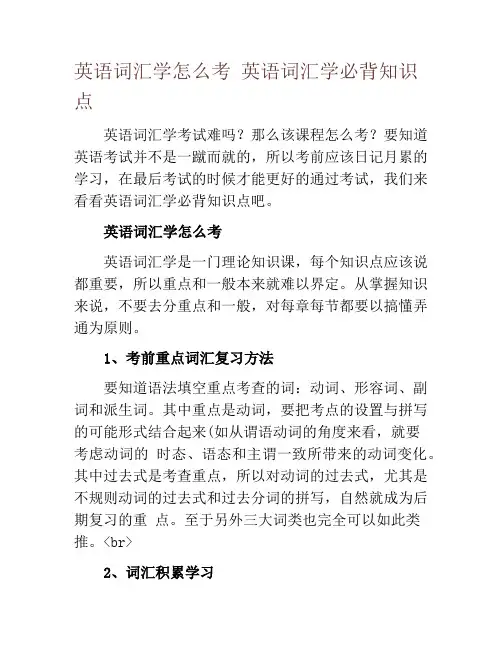
英语词汇学怎么考英语词汇学必背知识点英语词汇学考试难吗?那么该课程怎么考?要知道英语考试并不是一蹴而就的,所以考前应该日记月累的学习,在最后考试的时候才能更好的通过考试,我们来看看英语词汇学必背知识点吧。
英语词汇学怎么考英语词汇学是一门理论知识课,每个知识点应该说都重要,所以重点和一般本来就难以界定。
从掌握知识来说,不要去分重点和一般,对每章每节都要以搞懂弄通为原则。
1、考前重点词汇复习方法要知道语法填空重点考查的词:动词、形容词、副词和派生词。
其中重点是动词,要把考点的设置与拼写的可能形式结合起来(如从谓语动词的角度来看,就要考虑动词的时态、语态和主谓一致所带来的动词变化。
其中过去式是考查重点,所以对动词的过去式,尤其是不规则动词的过去式和过去分词的拼写,自然就成为后期复习的重点。
至于另外三大词类也完全可以如此类推。
<br>2、词汇积累学习加强短文背诵,增强“词不离句”意识。
背诵是非常原始的英语学习方法,但也是非常积极、有效的学习方法。
优选一些名家名篇,做为背诵的素材;或从课文中精选一些精悍之作,作为研习的精典,不但能够迅速提高语感,而且容易激发兴趣,形成活生生的词库,为单词的准确使用打下良好的基础。
3、英语主观题拿分技巧首先是单词拼写,这是所有题目中考生得分最低的一个部分,通常平均分不超过3分,所以大家不要太在意,20个单词,对4个,能有2分就很不错了,如果想要提高这部分,大家还要有准备的背单词,因为这里面的单词,并不全是课本课后单词表的单词,其中很多都是以前在中学学过的,所以要准备这一部分,需要的是买一本自考英语的词汇大纲,按里面的词汇背记才有意义。
如果大家对英语词汇学课程学习有难度,那么可以通过在线视频学习的,以上三点就是学赛小编对英语词汇学必背知识点学习方法,希望大家能更好的学习。
点击进入>>>。
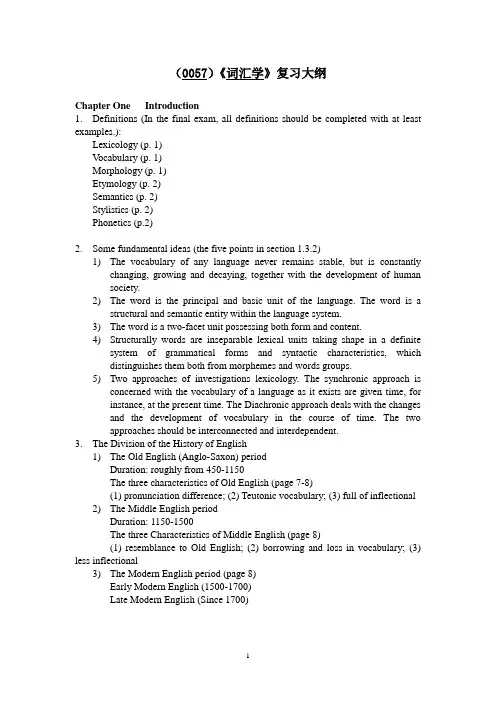
(0057)《词汇学》复习大纲Chapter One Introduction1. Definitions (In the final exam, all definitions should be completed with at least examples.):Lexicology (p. 1)V ocabulary (p. 1)Morphology (p. 1)Etymology (p. 2)Semantics (p. 2)Stylistics (p. 2)Phonetics (p.2)2. Some fundamental ideas (the five points in section 1.3.2)1) The vocabulary of any language never remains stable, but is constantlychanging, growing and decaying, together with the development of humansociety.2) The word is the principal and basic unit of the language. The word is astructural and semantic entity within the language system.3) The word is a two-facet unit possessing both form and content.4) Structurally words are inseparable lexical units taking shape in a definitesystem of grammatical forms and syntactic characteristics, whichdistinguishes them both from morphemes and words groups.5) Two approaches of investigations lexicology. The synchronic approach isconcerned with the vocabulary of a language as it exists are given time, forinstance, at the present time. The Diachronic approach deals with the changesand the development of vocabulary in the course of time. The twoapproaches should be interconnected and interdependent.3. The Division of the History of English1) The Old English (Anglo-Saxon) periodDuration: roughly from 450-1150The three characteristics of Old English (page 7-8)(1) pronunciation difference; (2) Teutonic vocabulary; (3) full of inflectional2) The Middle English periodDuration: 1150-1500The three Characteristics of Middle English (page 8)(1) resemblance to Old English; (2) borrowing and loss in vocabulary; (3) less inflectional3) The Modern English period (page 8)Early Modern English (1500-1700)Late Modern English (Since 1700)Chapter Two Sources of English Vocabulary1. The naive elements of English V ocabulary1) The nine characteristics of the native element (pp. 10-11)a. all-national characterb. great stabilityc. mono-syllabic wordsd. Great word-forming abilitye. wide collocabilityf. plurality of meaningsg. high frequency valueh. stylistically neutral2. The foreign elements of English V ocabulary (pp. 11-26)1) The three ways of the foreign elements entering into the Englishvocabulary (p. 12)a. through oral speechb. through written speechc. through invaders2) Classification of the foreign borrowings (or, the four types of foreignelements in English vocabulary) (pp. 12-13)a. aliens ;b. denizens;c. translation loan;d. semantic loan3) Some useful Latin phrases and abbreviationsvice versa, per cent, per cap., persona non grata; a.m., p.m., i.e., e.g., c.f.,viz.4) doublets, hybrids and international words in English (pp. 26-30)5) The three types of assimilated words: completely assimilated words,partly assimilated words and non-assimilated words. (pp. 32-33) Chapter Three Word-Building1. Definitions (In the final exam, all definitions should be completed withexamples.):morpheme, free morpheme, bound morpheme, root, stem2. Ways of word-building (attentions should also be paid to the examplesappearing the ways of word-building)1) affixation (pp. 39-51)2) conversion (pp.51-55)3) compounding (pp.55-59)4) backformation (pp. 59-60)5) shortening (pp. 60-63)6) blending (pp. 63-64)7) imitation (p. 64)3. All the exercises of this chapter are possible sources for the final exam!Chapter Four Semantics1. definitions (In the final exam, all definitions should be completed withexamples.):polysemy (p. 72), homonymy (p. 77), perfect homonym (p. 77), homograph(p. 78), homophone p. 78), synonym (p. 80), antonym (p. 86),2. important points1) the relation between a word and its meaning (p. 70)2) the relation between words and concepts (p. 70-71)3) the meaning of “nice” (p. 72)4) types of synonyms (pp. 83-84)5) the origin of synonyms (p. 84)6) the example words of antonym (pp. 86-88)7) ways of coining neologism (p. 91)8) the exercises of Chapter Four (pp. 94-100)Chapter Five Change of Meaning1. Definitions (In the final exam, all definitions should be completed withexamples.):extension of meaning (p. 101), narrowing of meaning (p. 102), degradationof meaning (p. 104), metonymy (p. 114), synecdoche (p. 116), oxymoron (p.119)2. All the exercises of this chapter are possible sources for the final exam! Chapter Six English Idioms1. Characteristics of English idioms (four points) (pp. 124-128)2. Characteristics of phrasal verbs (three points) (pp. 133-134)3. All the exercises of this chapter are possible sources for the final exam! Chapter Seven Varieties of English1. Definitions (In the final exam, all definitions should be completed withexamples.):slang (p. 149), jargon (p. 149),2.All the exercises of this chapter are possible sources for the final exam!Chapter Eight American English1. Characteristics of American English (pp. 158-162)2. Differences between British English and American English (pp. 162-164)3.All the exercises of this chapter are possible sources for the final exam! Chapter Nine Application and Comprehension1. Attention should be paid to the example words given in this chapter2. All the exercises of this chapter are possible sources for the final exam! Chapter Ten English Lexicography1. Definitions (In the final exam, all definitions should be completed withexamples.):monolingual dictionary (p. 185), bilingual dictionary (p. 185), encyclopedia(p. 186), encyclopedic dictionary (p. 186).(0057)《词汇学》样题Part I Definition (20 points)Directions: Defining the following terms with examples.1. aliens2. homophone3. jargon4. compounding5. bilingual dictionaryPart II True or False Decision (15 points)Directions: Decide whether the following statements are T (true) or F (false).1.Every word has two aspects: the outer aspect —written form and the inner aspect —sound.2.Some affixes are free morphemes while some others are bound morphemes.3.Old English is a language of full inflections.4.“Popular words” mainly refer to words of French origin in the English language.5.Strictly speaking, in the English language, there are no two words which are absolutelyidentical in meaning6.We should put our hands on the deck, when we hear “All hands on deck” on a boat.7.In the word “modify”, the root is “mod”, the stem is “modi” and the suffix is “-fy”.8.Most of the affixes are derived from Old English, or from Latin and Greek.9.In the compound word “blood test”, the second part, i.e. “test”, indicates the action upon thefirst part.10.Absolute synonyms can be found in ordinary life, e.g. begin —commence.11.Simile, metaphor and personification are figures of speech based on resemblances.12.Phonologically, compounds can often be identified as having a main stress on the first elementand secondary stress on the second element.13.Actual meaning refers to the meaning of an isolated word in a dictionary.14.Most of the English words are polysemic.15.American English is characterized by creativeness but not conservativeness in usage.Part III Multiple Choice (15 points)Directions: There are 15 sentences in this section. Beneath each sentence there are 4 wordsor phrases marked A, B, C, and D. Choose the one word or phrase that correctly completes the sentence.1. The word “question” is a word borrowed from .A. LatinB. FrenchC. GreekD. Scandinavian2. He is wise enough to see all these fine pretensions.A. outB. toC. throughD. over3. You should remember that the building is a war memorial and speak more .A. respectivelyB. respectablyC. respectfullyD. respected4. The crown jewels are kept in the Tower of London.A. valuedB. valuelessC. invaluableD. usable5. When the crowd saw the prize-fighter stretched out on the canvas, shouts and cheersfrom it.A. broke upB. broke forthC. broke throughD. break upon6. The scientists realized it would be too to ship all people in one boatbecause it was fragile.A. boldB. daringC. riskyD. dangerous7. The energy gained from the sun can then be used during the night to enable the necessarychemical reactions to in his body.A. precedeB. proceedC. progressD. practise8. There is a of vegetables in Shanghai at the moment because of the coldweather.A. shortageB. wantC. needD. desire9. When the Victorians had family reunions, the hosts went their way to entertainthe guests.A. in forB. overC. out ofD. back on10. Having pushed her son, Eve gave him a dismissive towards the car.A. pushB. pullC. drawD. drag11. Which of the following usually appears in poems?A. horseB. steedC. gee-geeD. nag12. Which of the following words is INCORROCT in word formation?A. unhorseB. unmannedC. unfrostD. unhappy13. Which of the following is formed by blending?A. popB. sightseeC. copterD. boatel14. The antonym of “fresh” in “fresh bread” is ________.A. staleB. stuffyC. fadedD. tired15. I will take you to a most interesting ________ of nineteenth century.A. wonderB. exhibitionC. expositionD. displayPart IV Translation (10 points)Directions: Translating the following sentences into Chinese.1.The sea has smoothed down.2.Kissinger got the plans and helicoptered to Camp David.3.He commanded a fleet of thirty sails.4.Strike while the iron is hot.5.Most of the city families have a fridge.Part V Answer the following questions with examples (20 points)1.What are the relations between a word and its meaning? (6 points)2.What are the classifications of Homonyms? (6 points)3.What are the characteristic features of English idioms? (8 points)](0057)《词汇学》样题答案Part I Definition (20 points)1.aliensAliens are words borrowed from a foreign language without any change of the foreign sound and spelling. These words are immediately recognizable as foreign in origin. For examples, “coup d‟état”, “résumé”, “régime”, etc. are all Aliens of French borrowings.2.homophonesHomophones are words identical in sound but different in spelling and meaning, e.g. sun, son;piece and peace; etc.3.jargonJargon are terms peculiar to a class, sect, trade or profession. For example, when the chemist says “Chlorophyll makes food by photosynthesis.”he is talking jargon, which in plain language means “green leaves build up food with the help of light”.poundingCompounding is the word forming process by which tow or even more words are joined to form a new entity. For example, “darkroom (meaning …a room used for photographic processing‟) is formed by joining “dark” and “room” into a new word.5. bilingual dictionaryA bilingual dictionary involves two languages. The main entries are generally defined orexplained in the same language with translations as Oxford Advanced Learner’s Dictionary of Current English with Chinese Translation and Longman Dictionary of Contemporary English with Chinese Translation, etc.Part II True or False Decision (15 points)1~15. FFTTT 6~10 FTTTF 11~15TTFTFPart III Multiple Choice (15 points)1~5 ACCCB 6~10 CBACA 11~15 BCDABPart IV Translation (10 points)1.大海已经平静下来了。
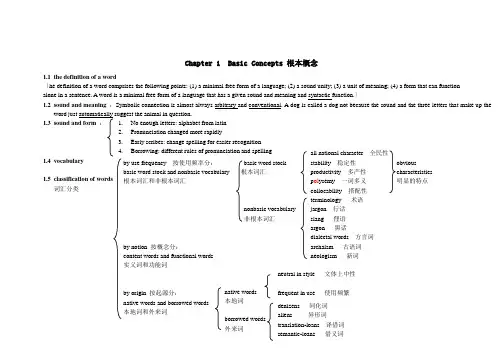
C h a p t e r 1 B a s i c C o n c e p t s 根本概念1.1 the definition of a word〔he definition of a word comprises the following points: (1) a minimal free form of a language; (2) a sound unity; (3) a unit of meaning; (4) a form that can function alone in a sentence. A word is a minimal free form of a language that has a given sound and meaning and syntactic function.〕1.2 sound and meaning :Symbolic connection is almost always arbitrary and conventional. A dog is called a dog not because the sound and the three letters that make up the1.31.4 vocabulary1.5 classification of words词汇分类basic word stock 根本词汇 nonbasic vocabulary 非根本词汇 by use frequency 按使用频率分: basic word stock and nonbasic vocabulary 根本词汇和非根本词汇 by notion 按概念分: content words and functional words 实义词和功能词by origin 按起源分:native words and borrowed words本地词和外来词all national character 全民性 stability 稳定性 productivity 多产性 p ol ysemy 一词多义 collocability 搭配性 terminology 术语 jargon 行话slang 俚语argon 黑话 dialectal words 方言词 archaism 古语词 neologism 新词 neutral in style 文体上中性 frequent in use 使用频繁 native words 本地词 borrowed words外来词denizens 同化词aliens 异形词translation-loans 译借词semantic-loans 借义词1. No enough letters: alphabet from latin2. Pronunciation changed more rapidly3. Early scribes: change spelling for easier recognition4. Borrowing: different rules of pronunciation and spelling obviouscharacteristics 明显的特点C h a p t e r2D e v e l o p m e n tIt is assumed that the world has approximately 3, 000 (some put it 5, 000 ) languages, which can be grouped into roughly 300 language families on the basis of similarities in their basic word stock and grammar.2.1 Indo-European印欧语Eastern set:东部诸语族:Western set:西部诸语族:Balto-Slavic 波罗的海-斯拉夫语Indo-Iranian 印度-伊朗语Armenian 亚美尼亚语Albanian 阿尔巴尼亚语Celtic 凯尔特语Italic 意大利语Hellenic 希腊语——GreekGermanic 日耳曼语Persian 波斯语Bengali 孟加拉国语Hindi 印地语Romany 普吉赛语Prussian 普鲁士语Lithuanian 立陶宛语Polish 波兰语Czech 捷克语Bulgarian 保加利亚语Slovenian 斯洛文尼亚语Russian 俄语Norwegian 挪威语Icelandic 冰岛语Danish 丹麦语Swedish 瑞典语German 德语Dutch 荷兰语Flemish 佛兰德语English 英语Portuguese 葡萄牙语Spanish 西班牙语French 法语Italian 意大利语Roumanian 罗马尼亚语Scottish 苏格兰语Irish 爱尔兰语Welsh 威尔士语Breton 布里多尼语Scandinavian languages斯堪的纳维亚语Latin 拉丁语言Historical review历史概述Growth of Present-day English Vocabulary 2.4 Modes of Vocabulary Development50000-60000 words 5万~6万间词汇Highly inflected 高度转折complex endings 复杂的结尾vowel changes 元音变化French words 法语词汇leveled endings 水平结尾Early Modern English (1500-1700)早期现代英语Late Modern English (1700-up to the present)晚期现代英语Borrow 借词new words 新词no endings 无结尾from a synthetic language (Old English) to the present analytic language。
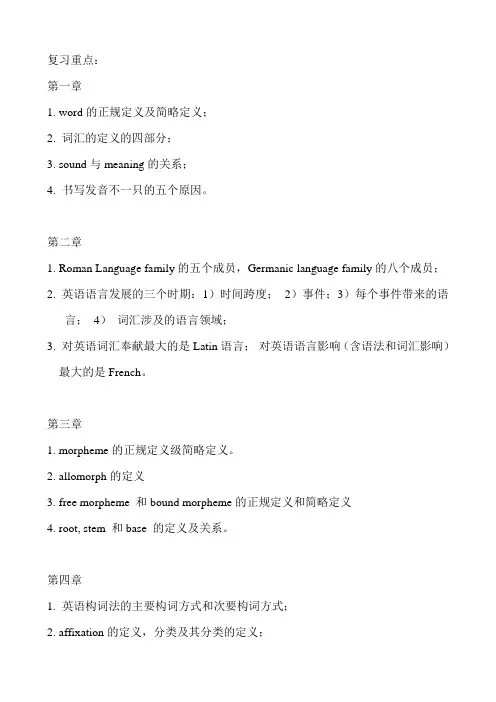
复习重点:第一章1. word的正规定义及简略定义;2. 词汇的定义的四部分;3. sound与meaning的关系;4. 书写发音不一只的五个原因。
第二章1. Roman Language family的五个成员,Germanic language family的八个成员;2. 英语语言发展的三个时期:1)时间跨度;2)事件;3)每个事件带来的语言;4)词汇涉及的语言领域;3. 对英语词汇奉献最大的是Latin语言;对英语语言影响(含语法和词汇影响)最大的是French。
第三章1. morpheme的正规定义级简略定义。
2. allomorph的定义3. free morpheme 和bound morpheme的正规定义和简略定义4. root, stem 和base 的定义及关系。
第四章1. 英语构词法的主要构词方式和次要构词方式;2. affixation的定义,分类及其分类的定义;3. compounding的定义及特点;4. shortening的种类;5. blending的定义;6. clipping的定义;7. acronymy的定义和种类及种类的定义;8. backformation的定义第五章1. reference,concept 和sense的定义;2. 词义的两部分的定义;3. 词汇意义的分类定义,下分类的定义;第六章1. polysemy 的定义2. homonymy的定义和分类级分类定义;3. synonymy的传统和现代定义和分类及分类的定义;4. antonymy的传统和现代定义和分类及分类的定义;。
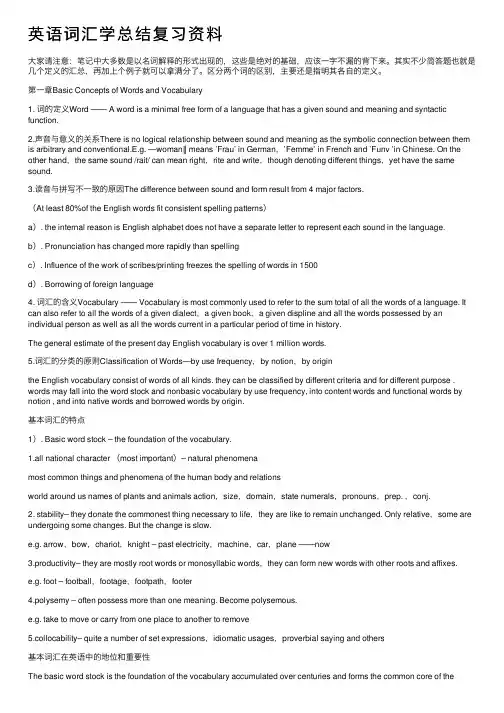
英语词汇学总结复习资料⼤家请注意:笔记中⼤多数是以名词解释的形式出现的,这些是绝对的基础,应该⼀字不漏的背下来。
其实不少简答题也就是⼏个定义的汇总,再加上个例⼦就可以拿满分了。
区分两个词的区别,主要还是指明其各⾃的定义。
第⼀章Basic Concepts of Words and Vocabulary1. 词的定义Word —— A word is a minimal free form of a language that has a given sound and meaning and syntactic function.2.声⾳与意义的关系There is no logical relationship between sound and meaning as the symbolic connection between them is arbitrary and conventional.E.g. ―woman‖ means ’Frau’ in German,’Femme’ in French and ’Funv ’in Chinese. On the other hand,the same sound /rait/ can mean right,rite and write,though denoting different things,yet have the same sound.3.读⾳与拼写不⼀致的原因The difference between sound and form result from 4 major factors.(At least 80%of the English words fit consistent spelling patterns)a). the internal reason is English alphabet does not have a separate letter to represent each sound in the language.b). Pronunciation has changed more rapidly than spellingc). Influence of the work of scribes/printing freezes the spelling of words in 1500d). Borrowing of foreign language4. 词汇的含义Vocabulary —— Vocabulary is most commonly used to refer to the sum total of all the words of a language. It can also refer to all the words of a given dialect,a given book,a given displine and all the words possessed by an individual person as well as all the words current in a particular period of time in history.The general estimate of the present day English vocabulary is over 1 million words.5.词汇的分类的原则Classification of Words—by use frequency,by notion,by originthe English vocabulary consist of words of all kinds. they can be classified by different criteria and for different purpose . words may fall into the word stock and nonbasic vocabulary by use frequency, into content words and functional words by notion , and into native words and borrowed words by origin.基本词汇的特点1). Basic word stock – the foundation of the vocabulary.1.all national character (most important)– natural phenomenamost common things and phenomena of the human body and relationsworld around us names of plants and animals action,size,domain,state numerals,pronouns,prep. ,conj.2. stability– they donate the commonest thing necessary to life,they are like to remain unchanged. Only relative,some are undergoing some changes. But the change is slow.e.g. arrow,bow,chariot,knight – past electricity,machine,car,plane ——now3.productivity– they are mostly root words or monosyllabic words,they can form new words with other roots and affixes.e.g. foot – football,footage,footpath,footer4.polysemy – often possess more than one meaning. Become polysemous.e.g. take to move or carry from one place to another to remove5.collocability– quite a number of set expressions,idiomatic usages,proverbial saying and others基本词汇在英语中的地位和重要性The basic word stock is the foundation of the vocabulary accumulated over centuries and forms the common core of thelanguage .though words of the basic word stock constitute a small percentage of the English vocabulary ,yet it is the most important part of it .e.g. heart – a change of heart, a heart of goldNon-basic vocabulary ——(例⼦)1. terminology –technical terms used in particular disciplines and academic areas as in medicinephotoscanning,hepatitis,indigestion,penicillin,algebra,trigonometry,calculus2. jargon– specialized vocabulary in certain professions.Bottom line,ballpark figures,bargaining chips,hold him back,hold him in,paranoid3. slang—— substandard words often used in informal occasionsdough and bread,grass and pot,beaver,smoky,bear,catch,holler,Roger,X-rays,Certain words are labeled slang because of their usage.4. argot – words used by sub-cultured groupscan-opener,dip,persuader cant,jargon ,argot are associated with,or most available to,specific groups of the population.5. dialectal words– only by speakers of the dialectbeauty,chook,cocky,station,auld,build,coo,hame,lough,bog6. archaisms – words no longer in common use or restricted in use. In older poems,legal document and religious writing or speech.7. neologism– newly created words with new meaning e.g. microelectronics,futurology,AIDS,internet,E-mailold meaning acquired new meaning e.g. mouse,monitor2). Content word (notional word)– denote clear notions.Functional word (empty word,form word)– do not have notions of their own,express the relation betweennotions,words and sentences.a. Content words constitute the main body of the English vocabulary are numerous.Functional words are in a small number.b. Content words are growing.Functional words remain stable.c. Functional words do far more work of expression than content words.3). Native words –are words brought to Britain in the 15 century by the German tribes. Ango-Saxon Words,50,000-60,000What is true of the basic word stock is also true of native world. More are1. neutral in style (not stylistical specific )2. 2.frequent in use (in academic fields and science French,Latin or Greek are used)(usage 70-90%)Borrowed words (loan words,borrowing)– words taken over from foreign language. 80%本族语词在英语中的地位和重要性Native words form the mainstream of the basic word stock and stand at the core of the language .therefore , what is true of the basic word stock is also true of native words.According to the degree of assimilation and manner of borrowing,we can bring the loan words under 4 classes.1.Denizen s– words borrowed early and now are well assimilated into English language.e.g. port from portus(L)shift,change,shirt,pork cup from cuppa(L)2.Aliens– retained their original pronunciation and spellinge.g. décor(F)blitzkreeg(G)emir,intermez,rowtow,bazaar,rajar,status quo3.translation loans– formed from the existing material in the English language but modeled on the patterns taken from another language.1). Word translated according to the meaninge.g. mother tough from lingua maternal(L)black humor from humor noir long time no see,surplus value,master piece 2). Words translated according to the sounde.g. kulak from kyrak(Russ)lama from lama(Tib)ketchup tea4. Semantic loans– their meaning are borrowed from another languagee.g. stupid old dump new sassy dream old joy and peace pioneer old explorer/person doing pioneering work new a member of the young pioneer fresh old impertinent,sassy,cheeky第⼆章The Development of the English1、Indo-European language family (Europe,the Near East,India)It can be grouped into an Eastern set :Balto –Slavic 、Indo-Iranian、Armenian and Albanian; a Western set: Celtic、Italic 、Hellenic、GermanicIn the Eastern set , Armenian and Albanian are each the only modern language respectively,the Balto –Slavic comprises such modern language such as Prussian、Lithuanian、Polish、Czech、Bulgarian、Slovenian、Russian. In the Indo-Iranian we have Persian, Bengali, Hindi, Romany, the last three of which are derived from the dead language Sanskrit.In the Western set, Greek is the modern language derived from Hellenic. In the Celtic,we find Scottish, Irish,Welsh, Breton. the five Romance language ,namely, Portuguese,Spanish, French, Italian, Roumanian all belong to the Italic through an intermediate language called Latin. The Germanic family consist of the four Northern European language :Norwegian, Icelandic, Danish and Swedish, which are generally known as Scandinavian languages. Then there is German, Dutch, Flemish and English.2、History (时间,历史事件,特征)1)Old English (450-1150)totally 50,000-60,000 wordsThe 1st people known to inhabit England were Celts,the language was Celtic.The second language was the Latin of the Roman Legions. The Germanic tribes called angles,Saxons and Jutes and their language,Anglo-Saxon dominated and blotted out the Celtic. Now people refer to Anglo-Saxon as old English. At the end of 6th century,the introduction of Christianity has a great impact on the English vocabulary. The common practice was to create new words bycombining two native words. In the 9th century,many Scandinavian words came into English. At least 900 words of Scandinavian are in modern English,our daily life and speech.特点:highly inflected language///complex endings or vowel changes (full ending)2)Middle English (1150-1500)English,Latin,FrenchUntil 1066,although there were borrowings from Latin,the influence on English was mainly Germanic. But the Norman Conquest started a continual flow of French words into English.By the end of the 13th century,English gradually come back into public areas.Between 1250 and 150 about 9000 words of French origin pouered into English. 75% of them are till in use today.As many as 2500 words of Dutch origin come into English.特点:fewer inflections leveled ending3)Modern English (1500-up to now)early modern English (1500-1700)late modern English(1700-up to now)The Renaissance(the early period),Latin and Greek were recognized as the languages of the West ern world’s great literary heritage.From the 1500’s through the 1700’s ,many writers experimented with words. Over 10000 new words entered the English language .many of these were taken from Latin and Greek .The Industrial Revolution was in the mid-17 century. With the growth of colonization,British tentacles began a stretching out of to every corner of the globe,thus enabling English to absorb words from all major languages of the world.After World War II,many new words have been created to express new ideas,inventions and scientific achievements. More words are created by means of word-formation.thousands and thousands of new words have been entered to express new ideas inventions,and scientific achievements. more words are created by means of word-formation.in modern English,word endings were mostly lost with just a few exceptions English has evolved from a synthetic language to the present analytic language.science and technology terms make up about 45% of new words. words associated with life-style constitute of 24% and social and economic terms amount to over 10% .mention should be made of an opposite process of development i.e. old words falling out if use.特点:ending are almost lost.3. Three main sources new words当代英语词汇发展的现状New words sweep in at a rate much faster than at any other historical period of time .词汇发展的主要原因1).The rapid development of modern science and technology2).Social: economic and political changes3).The influence of other cultures and languages4. Three modes of vocabulary development(英语发展的三个主要⽅式:创造新词、旧词新意、借⽤外来语词)1. Creation – the formation of new words by using the existing materials,namely roots,affixes and other elements. (This is the most important way of vocabulary expansion.)2. Semantic change - an old form which take on a new meaning to meet the new need.3. Borrowing – to take in words from other languages.(played a vital role in the development of vocabulary , particularly in earlier times)4. (Reviving archaic or obsolete)French 30%,Latin 8%,Japanese Italian 7%,Spanish 6%,German Greek 5%,Russian Yiddish 4%第三章Word Formation*1. Morpheme(词素) ——A morpheme is the smallest meaningful unit of a language. (The smallest functional unit in the composition of words.)*2.Morph—— A morpheme must be realized by discrete units. These actual spoken minimal carriers of meaning are morphs.3.Monomorphenic words– morphemes are realized by single morphs.4.Allomorph(词素变体)——Some morphemes are realized by more than one morph according to their position. Such alternative morphs are allomorphemes. E.g. the morpheme of plurality (-s)has a number if allomorphemes in different sound context,e.g. in cats/s/,in bags/z/,in matches/iz/.5. Free morphemes or Free root —— The morphemes have complete meaning and van be used as free grammatical units in sentences,e.g. cat,walk. They are identical with root words. morphemes which are independent of other morphemes are considered to be free.6.Bound Morphemes——The morphemes cannot occur as separate words. They are bound to other morphemes to form words,e.g. recollection (re+collect+ion)collect – free morpheme re-and –ion are bound morphemes. (include bound root and affix)Bound morphemes are found in derived words.7.Bound root ——A bound root is that part of the word that carries the fundamental meaning just like a free root. Unlike a free root,it is a bound form and has to combine with other morphemes to make words. Take -dict- for example:it conveys the meaning of ―say or speak‖ as a Latin root,but not as a word. With the prefix pre-(=before)we obtain the verb predict meaning ―tell beforehand‖。
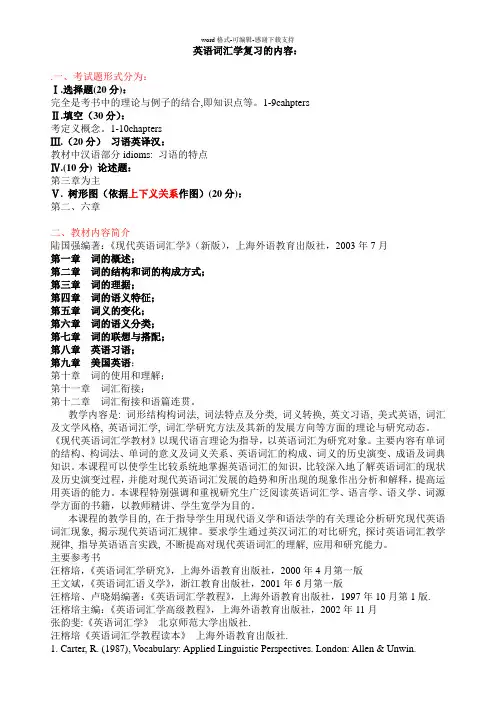
英语词汇学复习的内容:.一、考试题形式分为:Ⅰ.选择题(20分):完全是考书中的理论与例子的结合,即知识点等。
1-9cahptersⅡ.填空(30分):考定义概念。
1-10chaptersⅢ.(20分)习语英译汉:教材中汉语部分idioms: 习语的特点Ⅳ.(10分) 论述题:第三章为主Ⅴ. 树形图(依据上下义关系作图)(20分):第二、六章二、教材内容简介陆国强编著:《现代英语词汇学》(新版),上海外语教育出版社,2003年7月第一章词的概述;第二章词的结构和词的构成方式;第三章词的理据;第四章词的语义特征;第五章词义的变化;第六章词的语义分类;第七章词的联想与搭配;第八章英语习语;第九章美国英语;第十章词的使用和理解;第十一章词汇衔接;第十二章词汇衔接和语篇连贯。
教学内容是: 词形结构构词法, 词法特点及分类, 词义转换, 英文习语, 美式英语, 词汇及文学风格, 英语词汇学, 词汇学研究方法及其新的发展方向等方面的理论与研究动态。
《现代英语词汇学教材》以现代语言理论为指导,以英语词汇为研究对象。
主要内容有单词的结构、构词法、单词的意义及词义关系、英语词汇的构成、词义的历史演变、成语及词典知识。
本课程可以使学生比较系统地掌握英语词汇的知识,比较深入地了解英语词汇的现状及历史演变过程,并能对现代英语词汇发展的趋势和所出现的现象作出分析和解释,提高运用英语的能力。
本课程特别强调和重视研究生广泛阅读英语词汇学、语言学、语义学、词源学方面的书籍,以教师精讲、学生宽学为目的。
本课程的教学目的, 在于指导学生用现代语义学和语法学的有关理论分析研究现代英语词汇现象, 揭示现代英语词汇规律。
要求学生通过英汉词汇的对比研究, 探讨英语词汇教学规律, 指导英语语言实践, 不断提高对现代英语词汇的理解, 应用和研究能力。
主要参考书汪榕培,《英语词汇学研究》,上海外语教育出版社,2000年4月第一版王文斌,《英语词汇语义学》,浙江教育出版社,2001年6月第一版汪榕培、卢晓娟编著:《英语词汇学教程》,上海外语教育出版社,1997年10月第1版.汪榕培主编:《英语词汇学高级教程》,上海外语教育出版社,2002年11月张韵斐:《英语词汇学》北京师范大学出版社.汪榕培《英语词汇学教程读本》上海外语教育出版社.1. Carter, R. (1987), V ocabulary: Applied Linguistic Perspectives. London: Allen & Unwin.2. Carter, R. & M. McCarthy, (1988), V ocabluary and Language Teaching. Harlow; Longman.教学手段:采用多媒体教学本课程要求学生能够比较全面、比较系统地了解现代英语词汇学这一领域的一些最主要、最有影响的语言学理论,能够运用词汇学理论去分析和解决词汇学习中的一些问题。
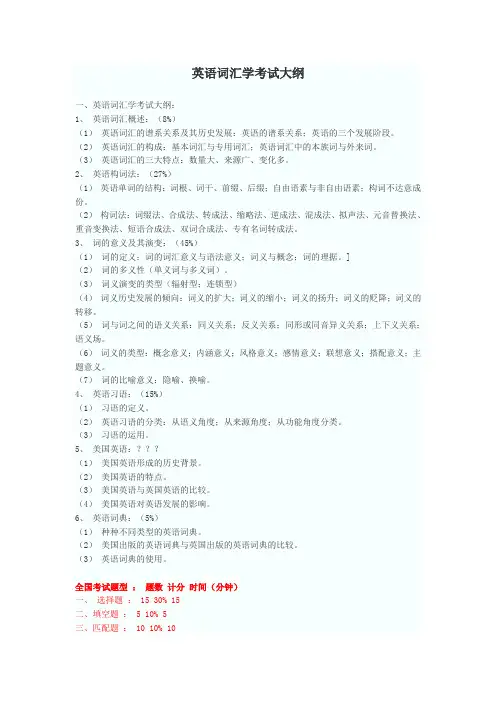
英语词汇学考试大纲一、英语词汇学考试大纲:1、英语词汇概述:(8%)(1)英语词汇的谱系关系及其历史发展:英语的谱系关系;英语的三个发展阶段。
(2)英语词汇的构成:基本词汇与专用词汇;英语词汇中的本族词与外来词。
(3)英语词汇的三大特点:数量大、来源广、变化多。
2、英语构词法:(27%)(1)英语单词的结构:词根、词干、前缀、后缀;自由语素与非自由语素;构词不达意成份。
(2)构词法:词缀法、合成法、转成法、缩略法、逆成法、混成法、拟声法、元音替换法、重音变换法、短语合成法、双词合成法、专有名词转成法。
3、词的意义及其演变:(45%)(1)词的定义;词的词汇意义与语法意义;词义与概念;词的理据。
](2)词的多义性(单义词与多义词)。
(3)词义演变的类型(辐射型;连锁型)(4)词义历史发展的倾向:词义的扩大;词义的缩小;词义的扬升;词义的贬降;词义的转移。
(5)词与词之间的语义关系:同义关系;反义关系;同形或同音异义关系;上下义关系;语义场。
(6)词义的类型:概念意义;内涵意义;风格意义;感情意义;联想意义;搭配意义;主题意义。
(7)词的比喻意义:隐喻、换喻。
4、英语习语:(15%)(1)习语的定义。
(2)英语习语的分类:从语义角度;从来源角度;从功能角度分类。
(3)习语的运用。
5、美国英语:???(1)美国英语形成的历史背景。
(2)美国英语的特点。
(3)美国英语与英国英语的比较。
(4)美国英语对英语发展的影响。
6、英语词典:(5%)(1)种种不同类型的英语词典。
(2)美国出版的英语词典与英国出版的英语词典的比较。
(3)英语词典的使用。
全国考试题型:题数计分时间(分钟)一、选择题: 15 30% 15二、填空题: 5 10% 5三、匹配题: 10 10% 10四、分类题: 10 10% 10五、名词解释: 5 10% 20五、简答题: 3 12% 30六、论述题: 2 18% 60合计: 50 100% 150(1)单项选择题 30分(每小题2分) 20(2)教程内容填空题 10分(每小题2分) 15(3)匹配题 10分(每小题1分) 15(4)判断填空题 10分(每小题1分) 20(5)术语解释题 10分(每小题2分) 20(6)简答题 12分(每小题4分) 30(7)分析题 18分(每小题9分) 30认知领域能力层次要求的分数比例识记(A) 20%领会(B) 30%简单应用(C) 30%综合应用(D) 20%课程中各章在试卷中的分数比例第一、二章 15%第三、四章 20%第五、六章 25%第七章 10%第八章 10%第九章 15%第十章 5%广东省考试题型:一、是非题: 10%,1分 *10题,共10分钟。
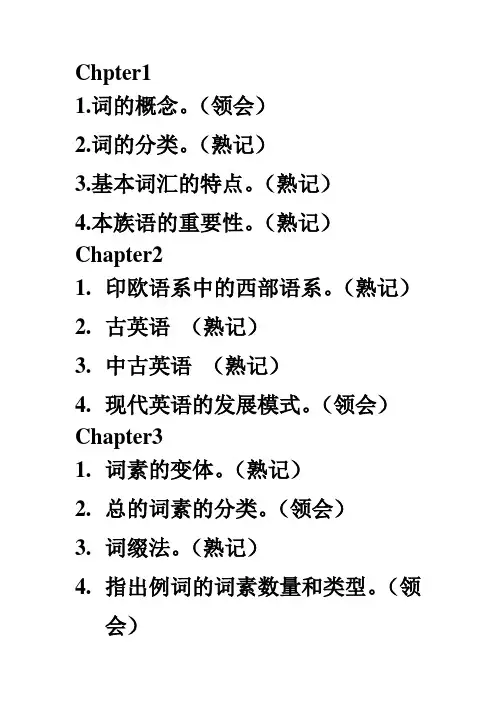
1.词的概念。
(领会)2.词的分类。
(熟记)3.基本词汇的特点。
(熟记)4.本族语的重要性。
(熟记)Chapter21.印欧语系中的西部语系。
(熟记)2.古英语(熟记)3.中古英语(熟记)4.现代英语的发展模式。
(领会)Chapter31.词素的变体。
(熟记)2.总的词素的分类。
(领会)3.词缀法。
(熟记)4.指出例词的词素数量和类型。
(领会)1.前缀的分类。
(熟记)2.转类法的类型。
(领会)3.部分转类法和完全转类法区别.(熟记)4.拼缀法类型。
(领会)5.截断法的概念。
(熟记)6.指出给的例词属于合成词,派生词,转类法的词,拼缀法,截断法,首字母缩略词,首字母拼音词,逆生法,来自于专有名词的词中的哪一个。
Chapter51.所指的概念。
(熟记)2.词的理据。
(熟记)3.理据的分类。
(领会)4.概念意义。
(熟记)5.褒义和贬义。
(领会)Chpter61.同义词的分类。
(熟记)2.反义词的分类。
(领会)3.上下义关系概念。
(熟记)4.语义场的作用。
(熟记)Chapter71.语义的扩大和缩小。
(领会)2.语义的降格。
(熟记)3.语境的作用。
(熟记)Chapter91.习语的特点。
(领会)2.习语的变异形式。
(领会)Chapter101. 单语词典和双语词典。
(熟记)。
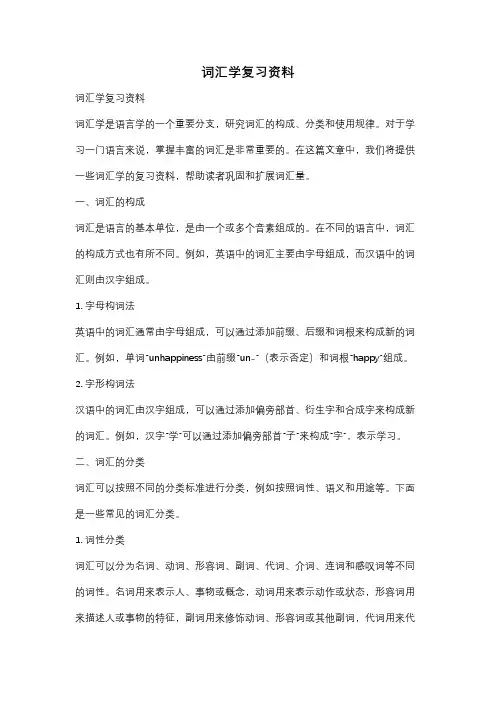
词汇学复习资料词汇学复习资料词汇学是语言学的一个重要分支,研究词汇的构成、分类和使用规律。
对于学习一门语言来说,掌握丰富的词汇是非常重要的。
在这篇文章中,我们将提供一些词汇学的复习资料,帮助读者巩固和扩展词汇量。
一、词汇的构成词汇是语言的基本单位,是由一个或多个音素组成的。
在不同的语言中,词汇的构成方式也有所不同。
例如,英语中的词汇主要由字母组成,而汉语中的词汇则由汉字组成。
1. 字母构词法英语中的词汇通常由字母组成,可以通过添加前缀、后缀和词根来构成新的词汇。
例如,单词“unhappiness”由前缀“un-”(表示否定)和词根“happy”组成。
2. 字形构词法汉语中的词汇由汉字组成,可以通过添加偏旁部首、衍生字和合成字来构成新的词汇。
例如,汉字“学”可以通过添加偏旁部首“子”来构成“字”,表示学习。
二、词汇的分类词汇可以按照不同的分类标准进行分类,例如按照词性、语义和用途等。
下面是一些常见的词汇分类。
1. 词性分类词汇可以分为名词、动词、形容词、副词、代词、介词、连词和感叹词等不同的词性。
名词用来表示人、事物或概念,动词用来表示动作或状态,形容词用来描述人或事物的特征,副词用来修饰动词、形容词或其他副词,代词用来代替名词,介词用来表示位置、时间或方式,连词用来连接词语或句子,感叹词用来表示强烈的情感。
2. 语义分类词汇可以按照词义的相似性进行分类。
例如,可以将名词按照人、动物、植物、物体、抽象概念等进行分类;将动词按照行为、状态、感觉、思维等进行分类;将形容词按照颜色、大小、形状、性质等进行分类。
3. 用途分类词汇可以按照在句子中的作用进行分类。
例如,可以将词汇分为实词和虚词。
实词包括名词、动词、形容词和副词,它们在句子中起到实际的意义;虚词包括代词、介词、连词和感叹词,它们在句子中起到连接或修饰的作用。
三、词汇的使用规律词汇的使用规律是指在特定语境中使用词汇的约束条件。
不同的语言和不同的语境中,词汇的使用规律也有所不同。
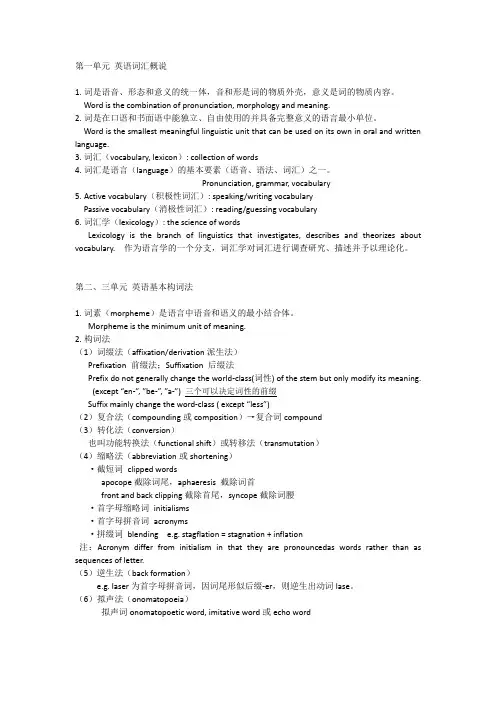
第一单元英语词汇概说1.词是语音、形态和意义的统一体,音和形是词的物质外壳,意义是词的物质内容。
Word is the combination of pronunciation, morphology and meaning.2.词是在口语和书面语中能独立、自由使用的并具备完整意义的语言最小单位。
Word is the smallest meaningful linguistic unit that can be used on its own in oral and written language.3.词汇(vocabulary, lexicon): collection of words4.词汇是语言(language)的基本要素(语音、语法、词汇)之一。
Pronunciation, grammar, vocabulary5.Active vocabulary(积极性词汇): speaking/writing vocabularyPassive vocabulary(消极性词汇): reading/guessing vocabulary6.词汇学(lexicology): the science of wordsLexicology is the branch of linguistics that investigates, describes and theorizes about vocabulary. 作为语言学的一个分支,词汇学对词汇进行调查研究、描述并予以理论化。
第二、三单元英语基本构词法1.词素(morpheme)是语言中语音和语义的最小结合体。
Morpheme is the minimum unit of meaning.2.构词法(1)词缀法(affixation/derivation派生法)Prefixation 前缀法;Suffixation 后缀法Prefix do not generally change the world-class(词性) of the stem but only modify its meaning.(except “en-”, ”be-”, ”a-”) 三个可以决定词性的前缀Suffix mainly change the word-class ( except “less”)(2)复合法(compounding或composition)→复合词compound(3)转化法(conversion)也叫功能转换法(functional shift)或转移法(transmutation)(4)缩略法(abbreviation或shortening)·截短词clipped wordsapocope截除词尾,aphaeresis 截除词首front and back clipping截除首尾,syncope截除词腰·首字母缩略词initialisms·首字母拼音词acronyms·拼缀词blending e.g. stagflation = stagnation + inflation注:Acronym differ from initialism in that they are pronouncedas words rather than as sequences of letter.(5)逆生法(back formation)e.g. laser为首字母拼音词,因词尾形似后缀-er,则逆生出动词lase。
第五章词的意义课程内容:一、“意义”的意义:所指、概念、语义的内容以及他们之间的区别二、词义的理据:词义的理据主要有四种:拟声理据、形态理据、语义理据、词源理据词义的理据与“约定俗成”的关系三、词义的类别词义主要包括:语法意义、词汇意义、概念意义、关联意义、内含意义、文体意义、感情意义、搭配意义要求:运用本章所学知识增强词义的理解能力,做到用词更加准确和得体第六章语义关系一、多义关系多义关系的形成。
多义关系的两种研究方法。
词义发展的两种模式:辐射型、连锁型二、同形同音异义关系同形同音异义词的定义、类别、来源。
同形同音异义词与多义词的区别及其修辞特色。
三、同义关系同义词的定义、类别、来源和区别同义词的方法。
四、反义关系反义词的定义、类别、特点及其使用。
五、上下义关系上下义词的概念。
上义词和下义词的特点及其使用。
六、语义场语义场的概念。
英语语义场与汉语语义场之间的异同。
第七章语义的演变课程内容:一、词义变化的种类词义的扩大、词义的缩小、词义的升华、词义的降格以及词义的转移四种变化方式在英语词汇发展中的作用二、词义变化的原因词义的演变的语言外部原因:历史原因、阶级原因、心理原因。
语言内部原因:缩略、借用、类推。
第八章语义与语境课程内容:一、语境的种类非语言语境。
语言语境:词汇语境和语法语境语境对词义的影响二、语境的作用语境如何消除歧义,限定所指和提供线索要做到利用语境知识猜测词义第九章英语习语课程内容:一、英语习语的特点英语习语的特点可概括为两点:语义的整体性和结构的稳定性二、英语习语的分类英语习语有不同的分类原则,根据习语的语法功能可分为名词性习语、形容词性习语、动词性习语、副词性习语和句式习语三、英语习语的使用习语的文体色彩;修辞色彩,包括各种修辞格;习语的变异形式。
注意收集习语,并分析它们的构成形式、语法功能和修辞特色。
第十章英语词典一、词典的种类单语词典与双语词典;语文词典与百科词典;大型词典、案头词典和袖珍词典;专用词典。
Chapter11.word:A word is the smallest unit of spoken written language which has meanings and can stand alone. A word is a minimal free form that has a given sound and meaning and syntactic function2. A word is(1)A minimal free form of a language;(2)a sound unity;(3)a unity of meaning;(4)a form that can function alone in a sentence.3.1 the physical structure of the word(1)Phonetics is the branch of linguistics which studies the characteristics of speech sounds and provides methods for the description, classification and transcription.(2)Morphology is the branch of linguistics, which studies the internal structure of words and rules by which words are formed. In other words, it identifies the smallest meaningful units in a language which are called morphemes and look into the ways the morphemes are arranged to form words.2.2 the semantic structure of the word(1)the word is a unit of speech or writng, which serves the purposeful human communication.(2)the word can be perceived as the total of the sounds that comprise it(3)the word , in writing, is seen as a sequence of letters bounded on either side by a blank space.(4)the word, viewed linguistically, possesses its physical structure (form) and semantic structure (meaning).4.V ocabulary:V ocabulary refers to all the words used in a particular kind of work, business or known to a particular person.5.V ocabulary and Lexis :Lexi, a mass noun, is defined as the total stick of words in a language.6.Lexicology: the study of meaning and uses of words论述对词汇学的理解包括内容:Lexicology is the part of linguistics which studies words. This may include their nature and function as symbols, their meaning, the relationship of their meaning, and the rules of their composition from smaller elements. Lexicology also involves relations between words, which may involve semantics, derivation, usage and sociolinguistic distinctions. Any other issues involved in analyzing the whole lexicon of a languages.Chapter21.The development of English vocabulary. The history of English language can be divided into 3 periods:a/ Old English period (449—1100)the former inhabitants, the Celtic, the Germanic tribes called Angles, Saxons and Jutes Anglo-Saxon as Old English, Old English contains 50-60 thousand words, which consists of the basic word stock.*3个重大事件:(1)Teutonic Conquest 乔顿征服(2)Christianity(Latin word)(3)Scandinavian invasionb/ Middle English period (1100-1500)characterized by the strong influence of French following the Norman Conquest in 1066.The French loan words were found in law and governmental administration (judge, justice)1150-1204:French occupied the dnoinant position1204-1500:English gradually come back to a positionc/ Modern English period (1500--)the early stage of this period ( including the years between 1500-1700), the Renaissance brought great changes to the vocabulary. borrowing from Latin, Latin were now mostly connected with science and abstract ideas. Greek borrowings were mostly literary, technical and scientific words2.The origins of English words2.1 the native words: Anglo-Saxon elements2.2 the loan words: French, Latin, Greek, Scandinavian, other European elements, ChineseChapter31. American English: is the form of English used in the United States. It includes all English dialects used within the United States.2. British English: is the form of English used in the United Kingdom. It includes all English dialects used within the United Kingdom.3. The history:(1)17th century: The English language was first introduced to the American by British colonization, beginning in 1607 in Jamestown, Virginia.Early in the 17th century, the English settlements in Virginia and Massachusetts began the main stream of what we recognize as the American history.The language taken there was Elizabethan English(2)The War of Independence : It marks the end of the colonial period.The political independence brings the tendency to develop an American brand of English.4.Americanism: A word, phrase or idiom characteristic of English as it is spoken in the US.5.Difference: pronunciation / spelling/ vocabulary / habitual expression/ grammarChapter41.Neologism(新词): a neologism is a recently coined word, phrase or usage. It can also be an existing word or phrase which has been assigned a new meaning.Chapter51.morpheme:A morpheme is the minimal meaningful units of which the language is composed. Morphology refers to the study of the internal structure of words, and the rules by which words are formed.2.分类:(1)free morphemes (自由词素)(2)bound morphemes (黏着词素): bound root +affixA. Inflectional affixes (-s ,-es ,ing,-er ,or -(e)d,est)B. Derivational affixes(3)content and function morpheme(4)derivational and Inflectional morpheme3.Root, stem, base词根、词干、词基A root is that part of a word form that remains when all inflectional and derivational affixes have been removed. (词根是所有屈折词缀和派生词缀被去掉后所剩余的那部分)A stem is that part of the word-form which remains when all inflectional affixes have been removed.(词干是所有屈折词缀被去掉后所剩余的那部分)A base refers to a form to which affixes of any kind (both derivational and inflectional) can be added. It can be a root or a stem. (词基是任何一种词缀都可加在上面的形式)词根是所有屈折词缀和派生词缀被去掉后所剩余的那部分。
(完整word版)英语词汇学复习大纲整理1 B a s i c C o n c e p t s 基本概念1.1 the definition of a word(alone in a sentence. A word is a minimal free form of a language that has a given sound and meaning and syntactic function.)1.2 sound and meaning :symbolic connection is almost always arbitrary and conventional . A dog is called a dog not because the sound and the three letters thatmake up the word just automatically suggest the animal in question.1.3 sound and form :1.4 vocabulary 1.5 classification of words 词汇分类 basic word stock 基本词汇nonbasic vocabulary非基本词汇 by use frequency 按使用频率分: basic word stock and nonbasic vocabulary 基本词汇和非基本词汇by notion 按概念分:content words and functional words实义词和功能词by origin 按起源分: native words and borrowed words 本地词和外来词 all national character 全民性stability 稳定性productivity 多产性polysemy 一词多义collocability 搭配性terminology 术语jargon 行话slang 俚语argon 黑话dialectal words 方言词archaism 古语词neologism 新词neutral in style 文体上中性frequent in use 使用频繁native words本地词 borrowed words 外来词 denizens 同化词aliens 异形词translation-loans 译借词1. No enough letters: alphabet from Latin2. Pronunciation changed more rapidly3. Early scribes: change spelling for easier recognition4. Borrowing: different rules of pronunciation and spelling obviouscharacteristics明显的特点(Functional words do not have notions of their own and their main function is to express the relation betweennotions, words, etc.)2D e v e l o p m e n tIt is assumed that the world has approximately 3, 000 (some put it 5, 000 ) languages, which can be grouped into roughly 300 language families on the basis of similarities in their basic word stock and grammar.2.1 Indo-European印欧语Eastern set:东部诸语族Western set:西部诸语族Balto-Slavic 波罗的海-斯拉夫语Indo-Iranian 印度-伊朗语Armenian 亚美尼亚语Albanian 阿尔巴尼亚语Celtic 凯尔特语Italic 意大利语Hellenic 希腊语—Greek Germanic 日耳曼语Persian 波斯语Bengali 孟加拉国语Hindi 印地语Romany 普吉赛语Prussian 普鲁士语Lithuanian 立陶宛语Polish 波兰语Czech 捷克语Bulgarian 保加利亚语Slovenian 斯洛文尼亚语Russian 俄语Norwegian 挪威语Icelandic 冰岛语Danish 丹麦语Swedish 瑞典语German 德语Dutch 荷兰语Flemish 佛兰德语Portuguese 葡萄牙语Spanish 西班牙语French 法语Italian 意大利语Roumanian 罗马尼亚语Scottish 苏格兰语Irish 爱尔兰语Welsh 威尔士语Breton 布里多尼语Scandinavian languages 斯堪的纳维亚语Latin 拉丁语言2.2 Historical review历史概述2.3 Growth of Present-day English Vocabulary 2.4 Modes of Vocabulary Development 50000-60000 words 5万~6万间词汇Highly inflected 高度曲折complex endings 复杂的结尾vowel changes 元音变化French words 法语词汇leveled endings 水平结尾Early Modern English (1500-1700)早期现代英语Late Modern English (1700-up to the present)晚期现代英语Borrow 借词new words 新词no endings 无结尾(from a synthetic language (Old English) to the present analytic language。
词汇学第二章知识点总结第一节语言单位1. 语言单位:词、词组、句子和语法结构词:语言的最小单位词组:由几个词构成的语言单位句子:由词或词组构成的具有完整意义的语言单位语法结构:句子的组织形式,包括层次结构、句子成分、语法关系等2. 词的构成词素:构成词的最小语音和语义单位,可以独立存在或在词中进行构词词根:词的核心,在构词中起着基本作用词缀:附着在词根上,用于构成新词或改变词的词类、意义等词素内部结构:构成词素的内部组合形式3. 词的分类词的词类:名词、动词、形容词、副词、代词、数词、量词和介词词的形式:词的屈折、派生、合成等形式第二节词的意义和词的结构1. 词的意义词义:词语所标示的概念、概括和概念内的发展词语义变化:词义的泛化、特指和引申等变化词的义位:构成词义的回路和成分词的词义关系:近义词、异义词和词义关系2. 词的结构词汇结构:构成词的词素和语音等结构形式词的成分结构:构成复词的内部词结构词语构词法:构成词的词缀、合成等构词手段第三节词义关系和词义演变1. 词义关系上下位关系:词义之间的概括和被概括关系同类词关系:在特定范畴或范围内词义之间的同类关系词语义联系:在使用中词义之间的联系和联系表达2. 词义演变词义的演变:在历史发展和使用中词义的变化和扩展词义变化类型:词义的泛化、转移、借代、内涵、外延等变化类型词义变化因素:历史、社会、文化、语言接触等诸多因素第四节词在句法中的功能和语意1. 词的句法功能词的句法功能:在句中词所承担的成分和功能句法结构:构成句子的各种句法成分的组织形式2. 词的语义特征词的语义特征:词的语义属性和特别意义词的意义转换:词义在句法中的隐喻、比喻、借代和辞让等转换方式词义在句法中的表现:词义在句中所呈现的语义特征和语义表达第五节词汇的心理基础1. 词汇的心理组织词的心理存储:词的存储方式和内部心理结构词汇记忆:词的认知和记忆方式及其规律词的心理连接:词之间在心理中的联结和联系2. 词汇的心理活动词的心理组织:词的认知、思维、理解、表达等心理活动词的心理过程:词的产生、使用、决策、回忆、判断等心理过程第六节词汇习得和使用1. 词汇的习得语言习得:语言学习者获取和掌握词汇的过程词汇习得理论:第一语言习得和第二语言习得的理论及其实践词汇习得策略:词汇习得过程中的学习策略和方法2. 词汇的使用词汇的应用范畴:词汇在语言和交际中的各种应用范畴和方式词汇的使用规律:词汇在使用中的频率、变化、地域差异等规律词汇的使用技巧:词汇使用中的技巧、技能、风格等第七节词汇学的理论和研究方法1. 词汇学的理论词汇研究理论:词汇研究的主流理论和方法词汇学派别:各种词汇学派别对词汇研究的探索和发展词汇发展趋势:未来词汇研究的方向、趋势、发展和应用2. 词汇学的研究方法词汇的研究方法:词汇的描述、分析、解释的研究方法和手段词汇的实证研究:词汇在使用中的实证研究方法和技术词汇的应用研究:词汇在语言学、教育学、心理学等领域的应用研究以上是词汇学第二章的知识点总结。
2023年自学考试专升本英语词汇学要如何复习?2023年的自学考试最早进行考试的地区目前已经开始了考试报名并将在明年1月开始考试,对于很多考生们来说,英语这一部分的考试内容在生活中的应用很少所以基本上在校期间学习的内容很多都忘记了,那么自学考试的英语要如何复习呢?快和小编一起来本文中看看吧!《英语词汇学》教程共十章,其涵盖的内容可以分为五大块:一、英语词汇的基本常识及其来源和发展;二、英语词汇的形态结构及构成方式;三、词的意义、关系及变化;四、英语习语;五、英语词典。
第一、二、三、四章主要讨论英语词汇的形式;第五、六、七、八章集中探讨词的意义;第九章论述习语,即“多成分”词语;第十章研究词典。
各章尽管长短不同,繁简各异,但每章都有一定数量的知识点,只是多寡不一。
至于哪些章节重要,哪些章节不重要很难确定。
应该说每个知识点都重要,知识点多的章节比知识点少的更重要。
不过,就其实用性而言,还是有区别的。
英语词汇的构成方式、词的意义、语义关系、意义与语境等章节相比之下更为实用,更能锻炼语言综合应用能力。
①以本为本,所谓以本为本即以教材为中心,要是没有教材大家可以选择高三英语教材和大一英语教材为蓝本,每天坚持至少30分钟的阅读习惯。
对教材要求背诵的课文,每天阅读,因为我们背诵的单词是孤立的,只有结合到课文段落后才能形成互相联系能应用的持久记忆的单词,这点对基层薄弱的同学尤为重要。
②要及时复习和要尝试回忆记忆。
为什么我们单词看过就忘记,写过,甚至超过还是容易忘记。
因为我们没有及时复习,或者因为我们复习时方法不对,只是眼睛看,没有动手写,或者只是机械的抄写,其实这些都是效率低的复习,因为我们是一边工作一边备考,提高效率尤为重要。
根据遗忘艾宾浩斯遗忘曲线,在第一天是忘记的最快的,因此,我们要在第一天对前天的内容进行复习,采用滚动方式,对所有记忆的知识按计划进行循环记忆和练习。
③采用尝试回忆记忆提升记忆效率,其实学习的目的就是要落实到应试考试,考试又是思维和记忆的考验。
复习重点:
第一章
1. word的正规定义及简略定义;
2. 词汇的定义的四部分;
3. sound与meaning的关系;
4. 书写发音不一只的五个原因。
第二章
1. Roman Language family的五个成员,Germanic language family的八个成员;
2. 英语语言发展的三个时期:1)时间跨度;2)事件;3)每个事件带来的语
言;4)词汇涉及的语言领域;
3. 对英语词汇奉献最大的是Latin语言;对英语语言影响(含语法和词汇影响)最大的是French。
第三章
1. morpheme的正规定义级简略定义。
2. allomorph的定义
3. free morpheme 和bound morpheme的正规定义和简略定义
4. root, stem 和base 的定义及关系。
第四章
1. 英语构词法的主要构词方式和次要构词方式;
2. affixation的定义,分类及其分类的定义;
3. compounding的定义及特点;
4. shortening的种类;
5. blending的定义;
6. clipping的定义;
7. acronymy的定义和种类及种类的定义;
8. backformation的定义
第五章
1. reference,concept 和sense的定义;
2. 词义的两部分的定义;
3. 词汇意义的分类定义,下分类的定义;
第六章
1. polysemy 的定义
2. homonymy的定义和分类级分类定义;
3. synonymy的传统和现代定义和分类及分类的定义;
4. antonymy的传统和现代定义和分类及分类的定义;。